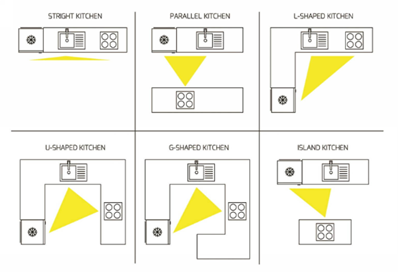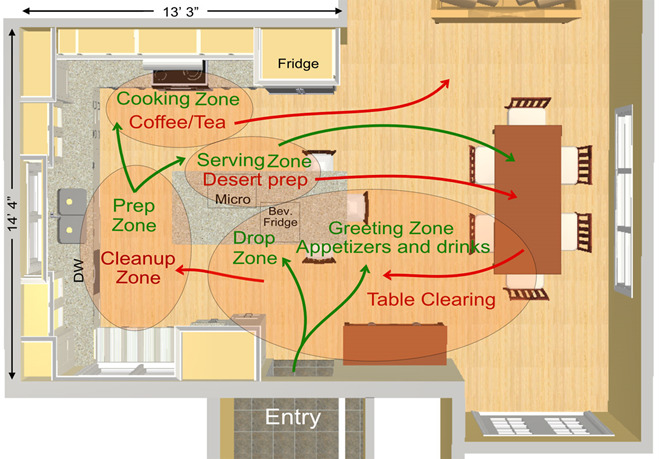Creating a High-Functioning and Beautiful Kitchen
Anyone who has worked in a poorly designed kitchen can attest to how important space planning is. Can you get to the cabinets with the dishwasher open? Does the oven door open into a walkway? Is there a drawer next to the cooktop to house a spatula or hot pad, is the serving ware adjacent to the serving zone? It’s not about size so much as function. A poorly planned large kitchen can be just as difficult to work in as a small kitchen. The appliance locations, work zones, countertop landing space, entrances/exits, and lighting placement too, are all worth your consideration.
Work Triangle or Work Zones? It depends on the size of your kitchen…
The idea of a kitchen triangle came about many decades ago as a way of reducing unnecessary steps between the refrigerator, range, and sink, and still works well in smaller kitchens. But today’s kitchens are typically larger, include more appliances, and have entertaining space. In this case, zoning your kitchen may be a better option. Your primary zones include:
- Work and prep zone
- Cooking zone
- Cleaning zone
Depending on space, you may have additional zones or maybe overlapping zones:
- Serving/Entertaining zone
- Homework zone
- Pet zone
- TV zone
- Drop zone (Keys, bags, shoes)


Whether a triangle or zoned kitchen would work better for you, always aim to:
- Have at least 18 inches of counter space on either side between appliances — except for under-counter appliances such as your dishwasher of course. It’s important to have a minimum of 12” on either side of a range. Locating the range top at the end of a run near a doorway or next to a wall is a recipe for disaster.
- Avoid placing appliances directly across from each other when planning an island to keep the pathway clear.
- Have counters on the sides of the refrigerator and the oven too, so there’s landing space to set down items as you are loading or removing them.
- Have storage and fridge in close range of the prep worktop, offering easy access to ingredients, utensils, pots, and pans.
- Have recycling and trash bins located near the prep and cleaning zones, so you can easily dispose of peelings and packaging without having to cross the kitchen.
- Have no more than two or three entrances/exits — more than that cuts into counter space and storage. Two ways in and out of the kitchen maintain a nice flow.
Need more storage? Go UP! Can your wall cabinets go taller? Maybe a nearby closet would work better as a pantry?
Need better accessibility? Consider roll-out trays in cabinets, or large drawers.
Want to have big family meals or have kids do homework in the kitchen? How about banquette seating in the corner?
Have room for an island? Make sure you have 36” to 48” between a double sided work space.
These are just some of the many considerations in planning a functional kitchen that your remodeling team will work through with you. As you can see there is much more to remodeling a kitchen than buying new cabinets and countertops!
And for the pretty bits:
Backsplash/Countertop, Light Fixtures, Open Shelving, Crown Molding/Hood, Handles, Pulls, Sink, Faucet, Color, Artwork/Collections… That is what gives your kitchen its uniqueness and personality. Do what you love and have fun with it!
Please do not hesitate to reach out with any questions you may have. Email us at Info@Oldenkamp.com or give us a call at 800-462-6047
Also, check out a few of our Partners.
Check out our vast Corian collection at our Royal Oak Showroom!
